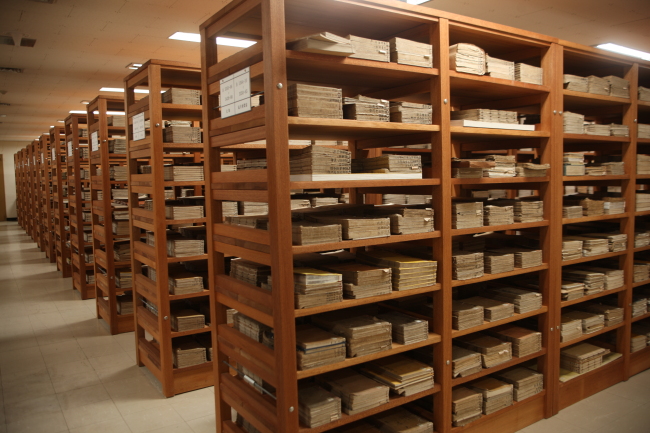

왜 우리는 책을 왜 읽을까? 우리는 왜 우리에 대한 기록을 남기고 싶어할까? 인류는 왜 도서관을 만들었을까?
규장각 한국학연구원 원장을 맡고 있는 서울대 국사학과 김인걸 교수는 화요일, 코리아 헤럴드와의 인터뷰에서 “우리 모두는 항상 지식에 대한 열망이 있어요. 그리고 책은 한 사람의 지식의 응집체이자, 어떤 주제에 대한 가장 객관적인 기록이므로, 우리가 정보를 얻을 수 있는 최고의 방법입니다.”고 서문을 뗐다.

규장각은 한국의 현존하는 가장 오래된 도서관이자, 기록보관소이다. 조선의 정조(1776-1800)가 전 세계에서 수집한 책들을 보관하기 위해 1776년경 창덕궁에 세웠다.
이곳은 또한 국왕이 조선 내 최고 학자들과 학문적 대화를 나누는 곳이기도 했다. 정조는 그들과 토론하면서 그들을 가르치기도 하고 그들로부터 배우기도 했다.
그러나 조선이 일본에 병합되면서, 규장각의 학문적 기능은 사라지고 그곳은 일본 식민지 정부에 의해 행정 문서들로 채워졌다. 1928년 당시 일본은 모든 자료들을 현재의 서울대학교로 옮겼다.
“한국 전쟁 시기에는 북한이 언어학자 홍기문으로 하여금 규장각의 모든 책들을 북한으로 가져가도록 지시했지만 인천상륙작전 이후 이를 철회했습니다. 북한의 김일성도 규장각 고문서들이 귀중한 자산이라는 사실을 알고 있었다고 합니다.”고 김 교수는 말했다.
그는 “매년 십 만 명의 사람들이 이곳에 방문하는데, 특히 한국사를 공부하는 사람들은 꼭 방문한다”고 밝혔다.
규장각은 유네스코 세계 기록 유산에 등재된 ‘조선 왕조 실록’, ‘승정원 일기’ 그리고 조선시대 왕실 의식에 대해 기록한 ‘의궤’, 오래된 지도들과 회고록을 포함한 26만 여 점의 고문서를 소장하고 있다.

규장각 지하에는 일반인들이 소장자료들을 볼 수 있도록 유리 벽을 설치해 전시실로 탈바꿈했다.
“고문서들은 단 몇 분내에 재로 변할 수 있을 정도로 굉장히 불에 약합니다. 그래서 특별 방화 시스템을 가동 중이지만 사람들의 출입을 제한하는 것이 최상의 보호책이겠지요.”고 김 교수는 말했다.
지하에는 왕실 의식 기록과, 서양의 기술을 차용해 짧은 시간에 완공한 수원 화성의 청사진, 왕실 규범에 대한 기록과 문학 작품들도 전시되어 있다.
오래된 책들은 지루할 것이라는 대중의 선입견과 달리, 이곳의 많은 책들이 형형색색의 사진과 함께 여러 의식에 대해 자세히 설명하고 있다. 이 책들만 봐도 우리는 그 당시 왕실 행사를 재현할 수 있다.
김인걸 교수는 “저는 사람들이 규장각을 당대 현인들이 후세대를 위한 현명한 결정을 내리기 위해 머리를 맞대었던 장소로 기억해 주길 바랍니다. 물론 인터넷으로도 이 모든 것들을 접할 수 있지만, 그것만으로는 생생한 흥분과 압도감을 느끼기엔 부족할 것입니다.”고 말했다.
(코리아 헤럴드 / 배지숙 기자)
Wisdom of the pages
Nation’s oldest library showcases knowledge of nation’s forefathers
By Bae Ji-sook
Why do people turn to books? Why do we want to leave records of ourselves? Above all, why do we need libraries?
“People have always had a craving for knowledge. And books, the condensed form of one’s knowledge or the most objective record of a certain topic, are the best way to obtain information,” said Kim In-geol, director and professor of the Kyujanggak Institute for Korean Studies at Seoul National University.
Kyujanggak is the oldest extant library and archive in Korea. It was founded as the royal library in 1776 in Changdeokgung Palace to store books King Jeongjo (who reigned from 1776-1800) collected from all around the world. It was also a place where the king freely shared academic ideas with the best scholars in the country. The king would debate with the scholars, sometimes test them and at other times learn from them.
But after Joseon was annexed by the Japanese, the library’s research function faded and the Japanese colonial government instead filled the bookshelves with various documents and other administrative information. The Japanese authorities moved Kyujanggak to what is now Seoul National University in 1928.
“During the Korean War (1950-1953), the North Korean government assigned linguist Hong Ki-mun to take away all Kyujanggak books to the North. However, after the Incheon Landing on Sept. 15, 1950, he was ordered to leave behind all books. It was reported that Hong was in deep despair and begged to be allowed to take them, only if he could have two or three more days,” Kim said. “Even Kim Il Sung knew that books are valuable assets to the country.”
Kim pointed out that books were a great way to leave accurate information useful to future generations.
“We have about 100,000 people a year visiting to read valuable books on just about anything from the mid-Joseon (1392-1910) era. Hundreds of papers were written based on the holdings, and anyone studying Korean history must visit this place,” he said.
Kyujanggak now contains more than 260,000 items including the “Annals of the Joseon Dynasty (Joseon Wangjo Sillok)” and the “Diary of the Office of Royal Secretaries (Seungjeongwon Ilgi),” both designated UNESCO World Documentary Heritages, as well as documents such as the royal illustrated texts of various state ceremonies (Euigwe), old maps and memoirs.
At the basement of the building is an observation room with a giant glass wall so that people can see into the storage room without going inside.
“Old books are highly flammable. Within minutes you can burn down the whole room. We have a special fire-proof system but we thought it best that entry into the storage be restricted to preserve the aging books,” said Kim.
In the exhibition room are old books ranging from records of royal ceremonies, construction blueprints of Suwon’s Hwaseong Castle -- which is known to have adopted Westernized engineering techniques resulting in a shortened construction period -- literary works as well as the royal code. In contrast to the public perception that the books are boring, many of them describe details about a certain event with colorful pictures.
“I hope people will always remember Kyujanggak as a place where the top people in academia gathered and collaborated to make the wisest decisions for future generations. Of course, you can just click and scroll on the Internet, but that doesn’t give you the same sensation and overwhelming feeling that you get from looking at the actual thing,” Kim said.
(baejisook@heraldcorp.com)










![[Robert J. Fouser] Social attitudes toward language proficiency](http://res.heraldm.com/phpwas/restmb_idxmake.php?idx=644&simg=/content/image/2024/05/16/20240516050799_0.jpg&u=)
![[Graphic News] How much do Korean adults read?](http://res.heraldm.com/phpwas/restmb_idxmake.php?idx=644&simg=/content/image/2024/05/16/20240516050803_0.gif&u=)





![[Herald Interview] Byun Yo-han's 'unlikable' character is result of calculated acting](http://res.heraldm.com/phpwas/restmb_idxmake.php?idx=652&simg=/content/image/2024/05/16/20240516050855_0.jpg&u=)
